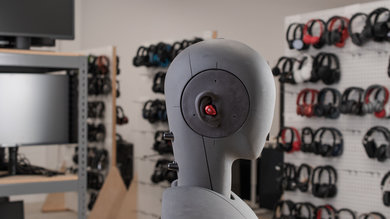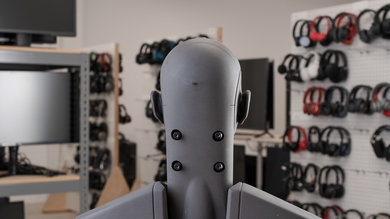Note: These headphones only seem to be available via Raycon's website.
Our Verdict
Sub-par for neutral listening. These in-ear headphones have a very dark and warm sound profile with overemphasized bass. These aren't an option for neutral listening.
- Decently comfortable, come with multiple tip options.
- Decently well-built design.
- Case improvements over the previous model; supports wireless charging.
- Bad microphone.
- Mediocre noise isolation.
- Only for bass fans.
Decent for commuting. They're really portable, but unfortunately, they won't drown out the engine rumble of a bus or train. On the upside, they do a good job at blocking ambient chatter. Their battery life should be long enough for your daily commute, but might not be enough for long flights.
- Decently comfortable, come with multiple tip options.
- Decently well-built design.
- Case improvements over the previous model; supports wireless charging.
- Bad microphone.
- Mediocre noise isolation.
- Only for bass fans.
Great for sports. Thanks to their truly wireless design, they're quite portable and breathable. Also, these headphones have a built-in rigid stability fin, which makes them very stable if you have a nice fit. Their warm and bass-heavy sound profile can keep you pumped, and they're rated IPX4 for water resistance.
- Decently comfortable, come with multiple tip options.
- Decently well-built design.
- Case improvements over the previous model; supports wireless charging.
- Bad microphone.
- Mediocre noise isolation.
- Only for bass fans.
Mediocre for the office. In-ears might not be comfortable for everyone to wear during a full work-day, and their 5-hour battery life won't be long enough for a whole day either. On the upside, their fit blocks out work environment noises like ambient chatter and the A/C system.
- Decently comfortable, come with multiple tip options.
- Decently well-built design.
- Case improvements over the previous model; supports wireless charging.
- Bad microphone.
- Mediocre noise isolation.
- Only for bass fans.
Bad for wireless gaming. Truly wireless headphones are usually not designed for gaming, as you'll get noticeable latency due to the Bluetooth connection.
These can't be used wired.
Sub-par for phone calls. Their microphone performance is quite bad, with recorded speech that sounds muffled and lacks detail. You're still understandable in quiet environments, but in slightly loud situations, the mic picks up environment noises too.
- Decently comfortable, come with multiple tip options.
- Decently well-built design.
- Case improvements over the previous model; supports wireless charging.
- Bad microphone.
- Mediocre noise isolation.
- Only for bass fans.
Changelog
- Updated Dec 20, 2022: Converted to Test Bench 1.5.
- Updated Feb 05, 2020: Converted to Test Bench 1.4.
- Updated Nov 21, 2019: Review published.
- Updated Nov 21, 2019: Early access published.
Check Price
Popular Headphones Comparisons
The Raycon E55 shouldn't be your first option to buy, unless you're a bass-only fan. Its sound profile is very warm with overemphasized bass, which drowns out vocals and instruments. They also feel rather cheap. See our recommendations for the best true wireless earbuds, the best budget wireless headphones, and the best earbuds for bass.
The Raycon E25 True Wireless are better than the Raycon E55 Truly Wireless in mixed usage. They have a lot in common and both have a very bass-heavy sound, but the E25 are more comfortable, have significantly better noise isolation, as well as a better mic for phone calls. On the upside, the E55 have a much more stable fit, making them a good choice for sports if you tend to have issues with earbuds falling out.
The Raycon E50 Truly Wireless and the Raycon E55 Truly Wireless are very similar, but the E55 have a more bass-heavy profile, which not everyone will like. Other than that, their earbud design is the same. On the other hand, the case of the E55 has some nice improvements over the E50, like a lid that doesn't fully remove itself and wireless charging compatibility.
The Jabra Elite 65t Truly Wireless are better overall headphones than the Raycon E55 Truly Wireless. They are better-built and their typical in-ear fit blocks more ambient noise, although it might not be as comfortable as the design of the E55. They can connect to two devices simultaneously, have a good app, and an overall more neutral sound profile, which can be EQ'ed to your preference. The E55 would be better for bass fans, but you can get quite a lot of bass with the Jabra EQ, without drowning the vocals and instruments too much.
The Raycon E100 Truly Wireless are more neutral-sounding than the Raycon E55 Truly Wireless and their overall performance is better. They also feel better built and their in-ear fit blocks more noise, although it isn't as comfortable as the E55's design.
Test Results

The Raycon E55 are practically identical in style to the Raycon E50 Truly Wireless and Raycon The Fitness Earbuds (2021 Edition) True Wireless. They're decently stylish truly wireless headphones that come in various colors to suit your preferred style. They're fairly small and don't protrude out of your ears too much.
The Raycon E55 are decently comfortable for in-ear headphones. They don't put too much pressure on the inside of your ear and don't enter your ear canal too deeply. They also come with multiple tip options, allowing you to find a more comfortable fit. However, the rigid stability fin might be bothersome for some, especially when listening during long periods. On the upside, they're very lightweight. If you want a slightly more comfortable Raycon option, check out the Raycon E25 Truly Wireless, or if you prefer something with an earbud design that doesn't enter the ear canal as deeply, consider the JBL TUNE 220TWS Truly Wireless.
The Raycon E55's control scheme is the same as the Raycon E50 Truly Wireless. It's straightforward and easy to get used to. A single tap play/pauses, double taps make you skip tracks forward and backward, and you can increase or decrease the volume with triple taps. Unfortunately, while having volume control is nice, triple taps take a long time to make multiple volume changes.
The Raycon E55's case is a nice improvement over the Raycon E50's. The lid is now fixed on the case instead of being magnetic and entirely removable. It also supports wireless charging, which is a nice addition. Also, the buds are now facing you in their natural direction, rather than being inverted upside down like they were in the E50's case.
The Raycon E55 are decently well-built. They feel dense enough to survive a few drops but aren't as high-end as some other headphones, like the Raycon E100. The materials used feel a bit cheap and their glossy finish is prone to fingerprints. On the upside, they're rated IPX4 for water resistance, although we don't test this internally.
Thanks to the integrated rigid stability fins, the Raycon E55 are very stable. Head movement doesn't make the headphones move inside your ears, which is great for sports. Unfortunately, you can't customize the size of the fins like you can with the Jaybird Vista Truly Wireless.
The Raycon E55 have a very bass-heavy and warm sound profile. They have noticeably more bass than the Raycon E50 Truly Wireless, which some may like. However, this drowns out the vocals and lead instruments quite a bit and clutters the whole mix. They also lack a lot of detail in higher frequencies, emphasizing even more the low-end frequencies. If you want truly wireless in-ears at a similar price-point that have a much better-balanced sound profile, check out the TaoTronics SoundLiberty 79 Truly Wireless.
The Raycon E55's frequency response consistency is great. Users should get a very consistent audio delivery every time they use the Raycon E55. There's a bit of bass variation, but this shouldn't be audible to most.
The bass of the E55 is not neutral at all. There's a very noticeable overemphasis in the high-bass, which makes the bass very muddy and boomy.
The mid-range accuracy is mediocre. The bump in low-mid is the continuation of the overemphasized bass, which results in cluttered vocals and lead instruments.
The treble accuracy is pretty bad. The whole range is uneven and noticeably under our neutral target. The E55 lack a lot of detail and brightness, which makes the bass even more powerful.
The Raycon E55 have quite a lot of peaks and dips that affect greatly its audio quality. The bump between high-bass and low-mid is very audible, making the headphones sound muddy and cluttered. The multiple dips in the treble results in voices, lead instruments, and sibilants to lack detail. There's a very noticeable tilt favoring bass frequencies.
The Raycon E55's stereo imaging is good. The group delay graph shows that it's entirely under the audibility threshold, which results in a tight bass and transparent treble range. Unfortunately, our unit had a fairly elevated frequency mismatch between the L/R drivers, which can create holes in the stereo image. Note that these results are only valid for our unit, and yours may perform differently.
The Raycon E55's soundstage is poor. This is because creating an out-of-head and speaker-like soundstage is largely dependent on activating the resonances of the pinna (outer ear). The design of in-ears and earbuds is in such a way that fully bypasses the pinna and doesn't interact with it. Also, because these headphones have a closed-back enclosure, their soundstage won't be perceived to be as open as that of open-back earbuds like the Apple AirPods (2nd generation) Truly Wireless, or the Bose SoundSport Free Truly Wireless.
The Raycon E55's weighted harmonic distortion is decent. It's within good limits in the bass range, but rises in higher frequencies, which may make some frequencies a bit impure and harsh, although this shouldn't be audible to most. On the upside, there's not a big jump under heavier loads, which is good.
The Raycon E55's noise isolation is quite mediocre. Their fit doesn't passively block a lot of noise and won't be the best option for commuting as they don't block low-end noises like the rumbling of an engine. On the upside, they do a decent job at blocking out ambient chatter and the noise coming from an A/C unit, making them okay for an office.
The Raycon E55's leakage performance is great. Like most in-ears, they practically don't leak and only higher-frequencies might leak a bit, resulting in a barely audible, thin-sounding leakage. You should be able to raise your listening volume to block out more noise, but we don't suggest blasting your music in very quiet environments.
The recording quality of the E55's integrated Bluetooth microphone is pretty bad. Recorded speech is muffled and lacks a lot of detail. Although people on the other end of the line are still able to understand you, the audio quality is poor.
The microphone's noise handling performance is mediocre. It struggles to separate speech from ambient noise in a moderately loud situation like a busy street, and will only be suitable for quiet environments.
The Raycon E55 have about 5 hours of continuous playback on a single charge, which should be enough for most people. they don't take too long to fully charge, and their case offers up to five additional charges, which is quite useful. Also, you can use one bud while the other is charging.
These headphones don't have a dedicated companion app.
These truly wireless headphones are Bluetooth 5.0 compatible. They have an excellent range, so you shouldn't have issues if you keep your source near you, but their latency is slightly above average for Bluetooth headphones. Some people may notice a delay when watching video content, although some apps and devices offer some sort of compensation for this.
These are Bluetooth-only headphones.















